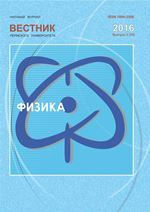On mechanism of large-scale transfer of molten metal components in non-uniformly heated thin capillaries
DOI:
https://doi.org/10.17072/1994-3598-2016-3-65-71Abstract
The results of numerical simulation for concentration-induced convection have been presented in this paper. Two-component melt of both liquid metals filling vertical thin capillary with non-uniform temperature distribution on the boundaries is considered. It is assumed that the condition of absolute nonwetting takes place on the sidewalls. Because of this effect there is a free surface on vertical boundaries, where thermocapillary force is appeared due to the external longitudinal temperature gradient which makes to move liquid elements at a big distance, compared with axial size of capillary. Processes of adsorption-desorption on a surface, thermocapillary force, motion in a volume and diffusion are characterized by essentially different times. These mechanisms generate a large-scale process of circulation as carrying-out of admixture on the surface in the hot higher part of capillary, its following transfer down along the boundary due to thermocapillary force and its return in the volume over the desorption in the lower part of capillary. The numerical calculations by the method of finite differences show that the lifting speed of returning motion in the volume is less, than on the surface, that’s why admixture in the stage of saturation can be accumulated nearby the lower part of capillary. After establishing the flow is stationary and determined as in the volume as on the surface by the Marangony number. Intensity of motion and processes of adsorption-desorption on the free boundary have the decisive influence upon the formation of surface and volume concentration fields and speed of redistribution of components in a mixture. Thus, one of the possible mechanisms of longitudinal division on components of liquid binary mixtures in thin channels has been demonstrated. This can explain the results of certain experiments with fusible metals on segregation of molten metal mixes.Received 17.10.2016; accepted 03.12.2016References
Glukhov A. F., Demin V. A., Tret’aykov A. V. On thermodiffusion influence on the dopant distribution during the freezing of binary liquid column. Bulletin of the Tomsk Polytechnic University. Geo Assets Engineering. 2015, vol. 326. no. 11, pp. 118–127.
Demin V. A., Gluhov A. F., Putin G. F. Separation of mixtures in connected channels. Journal of Applied Mechanics and Technical Physics, 2009, vol. 50, no. 1, pp. 58–65.
Demin V. A. Convective separators. Prikladnaia fizika (Applied Physics), no. 4, 2013, pp. 60-67 (In Russian).
Demin V. A. Sedimentation of nanoparticles in a homogeneous carrying fluid in the presence of thermodiffusion. Bulletin of Perm University. Physics, 2013, no. 1 (23), pp. 20–24.
Gavrilin I. V., Frolova T. B., Zaharov V. P. O likvatsii v zhidkih evtecticheskih splavah. Russian Metallurgy (Metally), 1984, no. 3. pp. 191–193 (In Russian).
Gavrilin I. V. Sedimentatsionniy eksperiment pri izuchenii zhidkih splavov. Russian Metallurgy (Metally), 1985, no. 2, pp. 66–73 (In Russian).
Gershuni G. Z., Zhukhovitskii E. M. Convective stability of incompressible fluids. Jerusalem: Keter Publishing House, 1976, 330 p.
Bratuhin U. K., Makarov S. O. Gidrodinamicheskaya ustoichivost’ mezhfaznyh poverhnostey (Hydrodynamic stabilify of interfaces). Perm: Perm University Press, 2005. 240 p. (In Russian).
Slavtchev S., Hennenberg M., Legros J.-C., Lebon G. Stationary solutal Marangoni instability in a two-layer system. Journal of Colloid and Interface Science, 1998, vol. 203, no. 2, p. 354–368.
Birikh R. V. Stability of homogeneous non-stationary surfactant diffusion through a flat interface between liquids Bulletin of Perm University. Series: Physics, 2016, no. 1 (32), pp. 64–70.
Tarunin E. L. Vychislitel'nyi eksperiment v zadachakh svobodnoi konvektsii (Numerical experiment in free convection problems). Irkutsk, Russia: Irkutsk University, 1990, 228 p. (In Russian).
Downloads
Published
How to Cite
Issue
Section
License
Автор предоставляет Издателю журнала (Пермский государственный национальный исследовательский университет) право на использование его статьи в составе журнала, а также на включение текста аннотации, полного текста статьи и информации об авторах в систему «Российский индекс научного цитирования» (РИНЦ).
Автор даёт своё согласие на обработку персональных данных.
Право использования журнала в целом в соответствии с п. 7 ст. 1260 ГК РФ принадлежит Издателю журнала и действует бессрочно на территории Российской Федерации и за её пределами.
Авторское вознаграждение за предоставление автором Издателю указанных выше прав не выплачивается.
Автор включённой в журнал статьи сохраняет исключительное право на неё независимо от права Издателя на использование журнала в целом.
Направление автором статьи в журнал означает его согласие на использование статьи Издателем на указанных выше условиях, на включение статьи в систему РИНЦ, и свидетельствует, что он осведомлён об условиях её использования. В качестве такого согласия рассматривается также направляемая в редакцию справка об авторе, в том числе по электронной почте.
Редакция размещает полный текст статьи на сайте Пермского государственного национального исследовательского университета: http://www.psu.ru и в системе OJS на сайте http://press.psu.ru
Плата за публикацию рукописей не взимается. Гонорар за публикации не выплачивается. Авторский экземпляр высылается автору по указанному им адресу.

